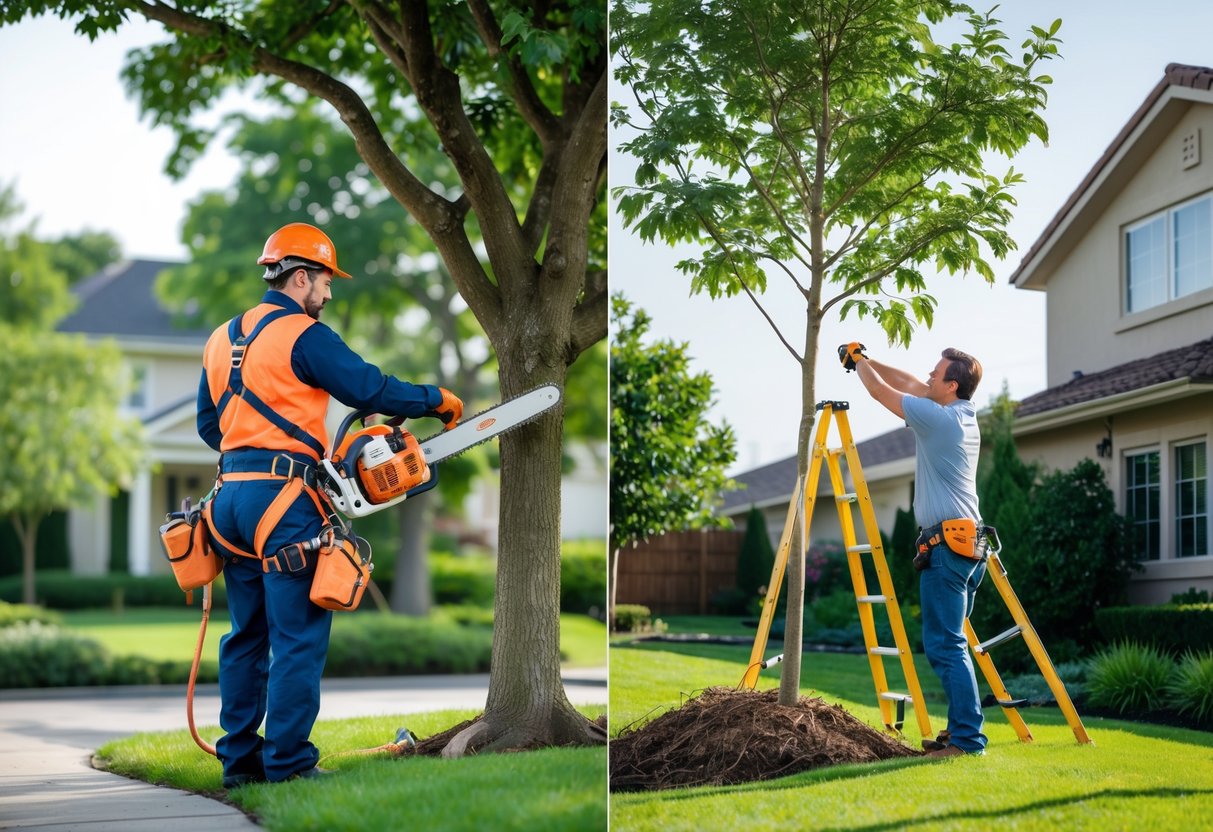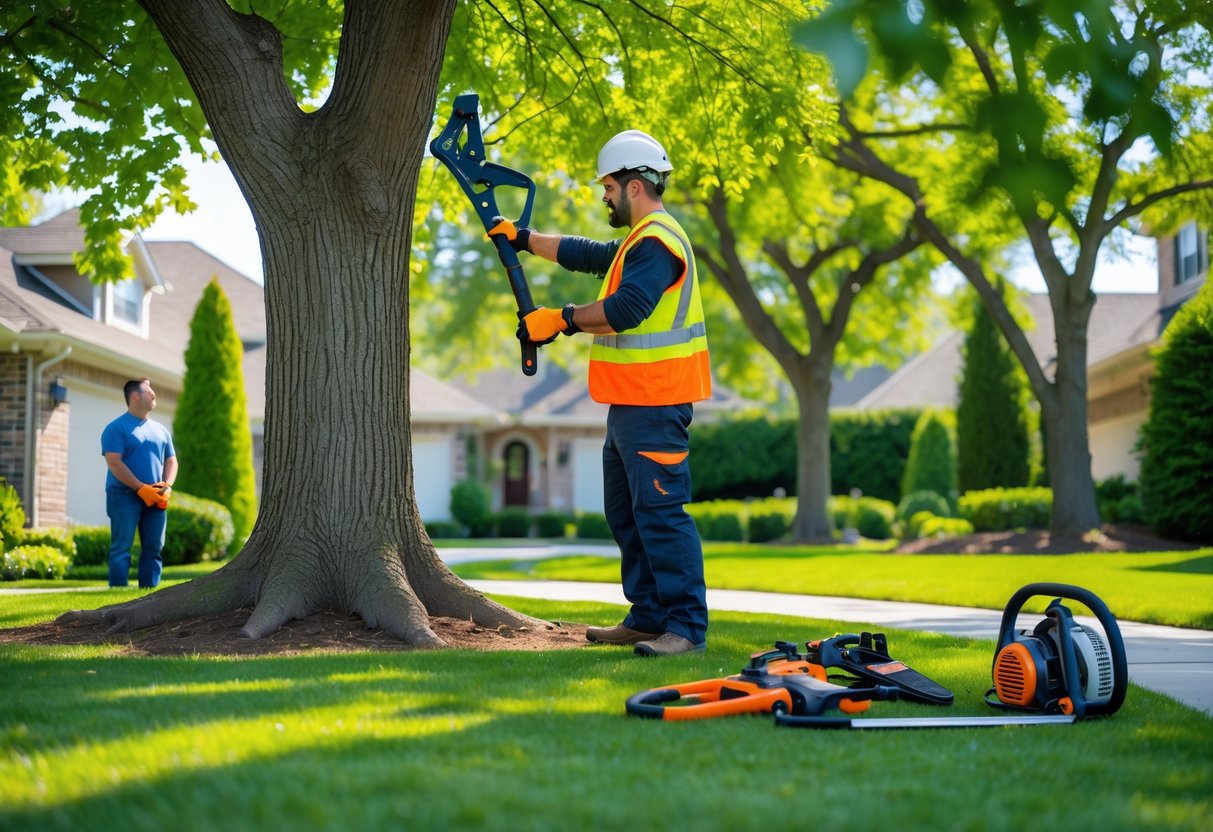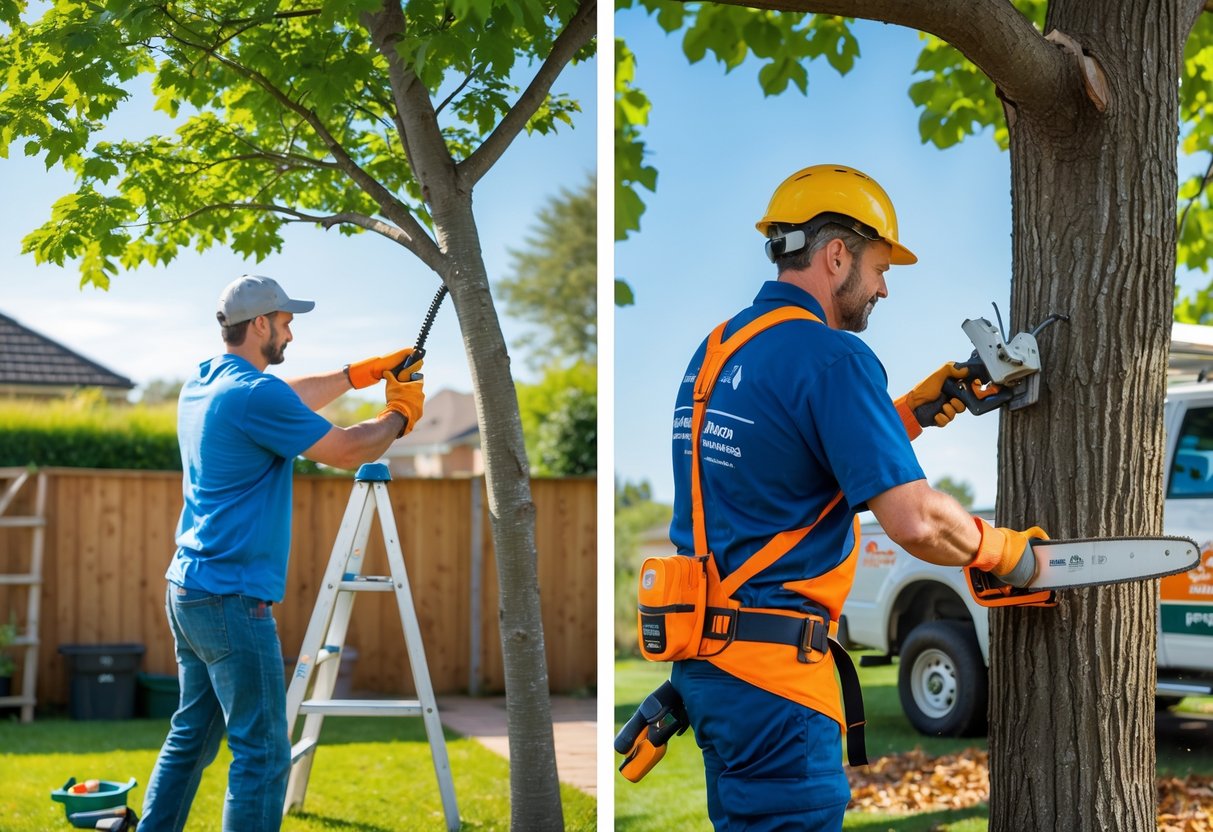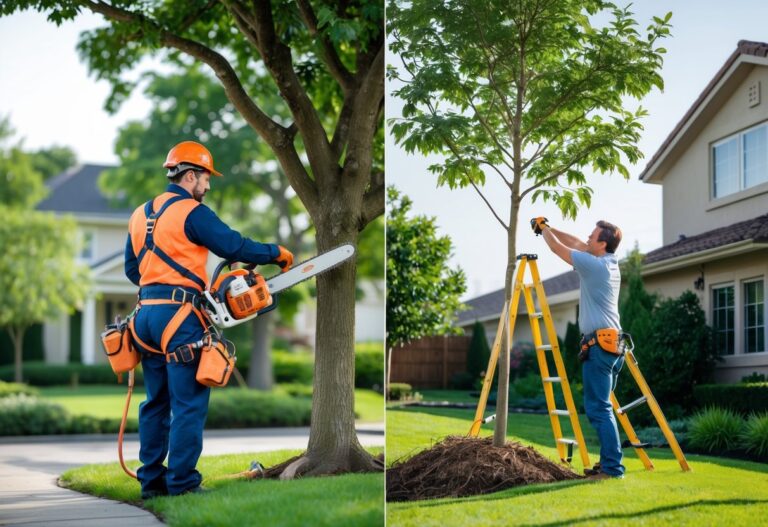Taking care of the trees on your property is important. But deciding whether to hire professional help or do it yourself can be tricky.
You need to weigh the benefits and drawbacks of both professional and DIY tree services to make the best choice for your situation. Safety, cost, and your own experience all play a part in this decision.

Professional tree services usually bring knowledge, equipment, and insurance. But they can be expensive.
Doing it yourself might save money and give you control, but it comes with certain risks and limitations. Knowing the strengths and weaknesses of each option helps you feel more confident about your choice.
Need a Home Fix – Emergency or Routine?
From leaks and no-heat nights to simple tune-ups, our 24/7 hotline connects you with trusted local pros in minutes.
Key Takeaways
- Professional and DIY tree services each have unique pros and cons.
- Weigh cost, safety, and experience before making a choice.
- The best option depends on your specific situation and needs.
Understanding Professional Tree Services

Professional tree services use industry training, special tools, and safety measures. These services usually offer a range of options, but costs and safety standards are important details to pay attention to.
Scope of Certified Arborists
Certified arborists are tree care experts. They must pass tests and follow ongoing training.
Their work includes tree pruning, trimming, removal, and treatment for diseases or pests. They can test soil, provide root care, and plant new trees properly.
Many also handle emergency services, like removing fallen limbs after storms. You can expect them to use equipment such as chainsaws, climbing gear, and wood chippers.
They also write reports if you need help with insurance claims or local rules. Certified arborists often carry insurance to protect you and your property.
Typical Costs and Service Packages
Professional tree services often use a clear price plan. Prices depend on the size, type, and condition of the tree, as well as location and service type.
Here is an example of what you might see:
| Service Type | Average Cost Range |
|---|---|
| Tree removal | $200 – $2,000+ |
| Basic pruning/trimming | $75 – $1,000+ |
| Emergency storm cleanup | $300 – $5,000+ |
Some companies offer package deals, like annual maintenance or combined trimming and fertilizing. Many give free estimates after looking at your trees in person.
Always ask what is included, such as debris removal or stump grinding, to avoid extra charges.
Safety Standards and Regulations
Safety is a top concern during tree work. Professionals must follow safety rules set by organizations such as OSHA (Occupational Safety and Health Administration).
Common steps include wearing helmets, gloves, and eye protection. Workers often use ropes, harnesses, and lift trucks, especially for tall trees.
Tree services must carry liability insurance and worker’s compensation. Many areas require permits for large tree removals—licensed professionals take care of this paperwork for you.
Professional companies also follow local and state laws to help avoid fines or legal trouble.
DIY Tree Services Explained

Doing tree work yourself can save money if you have the right skills, tools, and safety gear. Not every DIY tree task is safe or legal, and some jobs need permits or expert help.
Common Tasks for Homeowners
Many homeowners handle small-scale tree care. Pruning lower branches, removing dead wood, or planting young trees are typical tasks you can often do yourself.
Jobs like raking leaves, spreading mulch, and light trimming with hand pruners or loppers are usually safe. You might tackle removing small saplings or shaping hedges as well.
If a branch is high off the ground or very thick, it’s best to call a professional. Never climb large trees, cut big limbs, or use a chainsaw above shoulder height.
Working near power lines is extremely dangerous and requires a licensed expert.
Required Tools and Equipment
Basic tree care requires several simple and affordable tools:
| Tool | Purpose |
|---|---|
| Hand pruners | Cutting small branches |
| Loppers | Cutting thicker limbs (up to 2 inches) |
| Pruning saw | Cutting small to medium branches |
| Rake | Gathering leaves, twigs |
| Ladder | Reaching lower branches safely |
| Gloves & goggles | Hand and eye protection |
Optional items include a wheelbarrow for hauling branches and mulch. A pole pruner lets you reach slightly higher branches while standing on the ground.
Wear sturdy, nonslip shoes and never overreach with tools. You don’t need a chainsaw for most DIY tasks.
If you use power tools, follow all safety instructions. Check equipment for damage before every use.
Legal and Environmental Considerations
In some areas, cutting or removing trees on your property requires a permit. Local rules may also protect certain species or restrict what time of year you can perform tree work, especially if birds are nesting.
Improper pruning can harm trees or nearby wildlife. Never dump cut branches or leaves in public spaces—most cities have guidelines for green waste disposal.
If you live near wetlands or protected land, stricter rules may apply. Contact your town or city office before doing major work.
This helps you avoid fines and stay in compliance with local laws. Always consider how your actions affect neighbors and the environment.
Comparing the Pros and Cons
When deciding between professional and DIY tree services, it’s important to weigh the most significant details. Quality, cost, time, and safety can all impact your final choice.
Quality of Work and Expertise
Professional tree services use skilled workers trained in proper pruning and removal. They know how to care for different types of trees.
This lowers the risk of damaging the tree or your property. If you take the DIY route, your results may differ, especially if you lack the right tools or knowledge.
Mistakes, like improper cuts, can harm the tree or even cause it to die. While you might save money on labor, you may not achieve the same quality or long-term health for your trees.
Key differences:
| Aspect | Professional Service | DIY Approach |
|---|---|---|
| Skill Level | Certified and trained | Varies, often limited |
| Equipment | Specialized, professional-grade | Basic, may not be appropriate |
| Tree Health | Increases tree life/health | Risk of long-term tree damage |
Cost Efficiency and Budget Factors
Hiring professionals often costs more upfront. You pay for labor, equipment, and insurance.
Prices can range from $150 for small jobs to over $2,000 for large removals. With DIY tree care, your main costs are the tools, safety gear, and disposal fees.
If you already own equipment, your costs drop. However, buying a chainsaw, safety harness, and other tools can add up quickly.
In some cases, making a mistake while trying to save money can result in costly repairs to your property, your car, or even injury-related expenses.
Example cost comparison:
- Professional tree removal: $500 – $1,500
- DIY tree removal: $100 – $400 (if you need to buy or rent tools)
Time Investment and Convenience
Professionals can usually finish tree jobs faster. They have teams and specialized equipment to handle large branches or hazardous trees.
If you choose DIY, the job may take much longer, especially if you work alone. Tasks like pruning, cutting, cleanup, and disposal can take all day or even several days.
You might also need extra time to learn how to do the work safely. Expect delays if weather, equipment issues, or lack of help becomes a problem.
Hiring a service could be more convenient if you have a busy schedule or limited free time.
Safety Risks and Liability Issues
Tree service work is dangerous. Professionals use harnesses, helmets, and special tools. They follow safety guidelines and have insurance for accidents or damage.
DIY work has more risks, especially if you use ladders, chainsaws, or work near power lines. Falling, getting cut, or having branches land on power lines are real dangers.
DIYers are responsible for any injuries or property damage. In most cases, your homeowner’s insurance does not cover injuries you cause to yourself during DIY tree work.
Follow safety recommendations carefully if you try to do it yourself. Consider if avoiding risk is more important than saving money.
Making the Right Choice for Your Needs
Choosing between hiring a professional or handling tree work yourself often depends on safety risks, project size, and the long-term health of your trees. Your budget and personal skills also play key roles.
Evaluating Your Project Complexity
Some tasks, like removing small branches or light pruning, are safe for most homeowners. You only need basic tools, a ladder, and protective gear.
However, larger jobs—such as removing a full tree or cutting limbs near power lines—can be dangerous without training.
Here are some questions to help you judge complexity:
- How tall is the tree?
- Are there power lines nearby?
- Do you have the right equipment?
- Is the tree diseased or unstable?
Most injuries happen when people underestimate danger. If you are not completely sure about your ability or equipment, it may be safer to hire a professional.
Long-Term Value and Tree Health
The way trees are pruned or removed impacts their health and growth. DIY mistakes—like cutting too much, cutting at the wrong angle, or using dirty tools—can cause disease or weaken a tree.
Healthy trees need proper care to avoid rot, pest infestation, or dangerous limbs. Certified arborists know how to spot early signs of disease and how to make cuts that promote strong, balanced growth.
Good care also protects property value. Damaged or poorly maintained trees can be expensive to fix or remove later.
Investing in professional care can help trees live longer and reduce future costs.
When to Consult a Professional
You should contact a professional if:
- The tree is close to buildings or power lines.
- The job involves large limbs or a full tree removal.
- The tree appears diseased, stressed, or has lots of dead branches.
- You lack proper tools or training.
A professional arborist provides a safe work plan and can help you follow local rules. They also carry insurance, so you are protected if accidents happen.
For small jobs, you may be able to do the work yourself, but do not take risks with unclear or hazardous tasks.
Frequently Asked Questions
Picking the right tree service? It really comes down to safety, cost, skill, and what the law says. Sometimes, calling in a pro saves you a headache, but if you know what you’re doing, DIY could be easier on your wallet.
What factors should be considered when deciding between professional and DIY tree services?
First, check the tree’s size and species. Is it near power lines or buildings? That matters a lot.
Think about what tools you have and how comfortable you are using them. Health and safety should always come first.
How much time and effort are you willing to put in? Some trees are just more complicated than they look.
How do the costs of professional tree services compare with doing it yourself?
Hiring a professional usually costs more upfront. You’re paying for their labor, equipment, and insurance.
Going the DIY route might save you cash, but you might need to rent or buy tools. If something goes sideways, you could end up with extra bills for repairs or even medical care.
What are the potential risks associated with DIY tree trimming and removal?
DIY tree work can be risky. Falls, cuts, and even electric shocks can happen if you’re not careful.
Chainsaws and heavy branches are no joke without training. One wrong move and you could damage your home or make the tree unsafe.
What qualifications should a professional tree service provider have?
Always ask for proof of insurance and check if they’re licensed locally. Industry certifications, like from the ISA, are a good sign.
Experience counts, too. Look for positive reviews and make sure they use up-to-date safety gear. If they show up with the right equipment, that’s a good start.
How often should tree maintenance be performed by a professional, and can it be done effectively as a DIY project?
Most trees benefit from an inspection and some basic care once a year. Major pruning or taking down big trees? That’s usually best left to the pros.
For smaller stuff, like light trimming, you might be fine doing it yourself—if you’ve got a steady hand and know what to watch out for.
What are the legal and safety implications of performing tree services without professional help?
If you hurt yourself or someone else, you could end up on the hook for medical bills or damage to property.
Some areas actually require permits for certain types of tree work. Working close to power lines, or even on city property, without the proper license? That might land you with fines or worse, legal trouble.







Leave a Reply